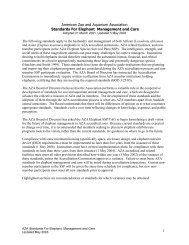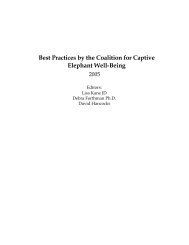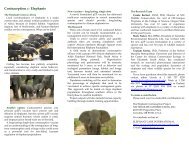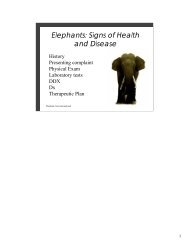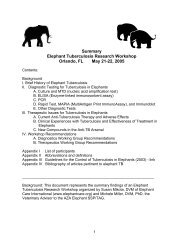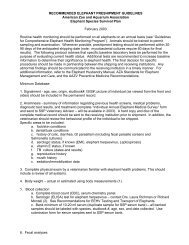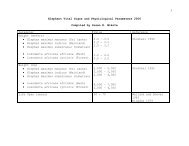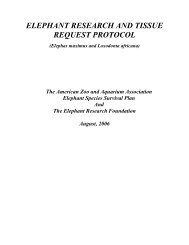Nepal Elephant TB Control and Mgt Action Plan.pdf - Elephant Care ...
Nepal Elephant TB Control and Mgt Action Plan.pdf - Elephant Care ...
Nepal Elephant TB Control and Mgt Action Plan.pdf - Elephant Care ...
- No tags were found...
Create successful ePaper yourself
Turn your PDF publications into a flip-book with our unique Google optimized e-Paper software.
<strong>Nepal</strong> <strong>Elephant</strong> Tuberculosis <strong>Control</strong> <strong>and</strong>Management <strong>Action</strong> <strong>Plan</strong> (2011-2015)being consumed reliably. Start EMB at 80% of thecalculated dose. If there are no problems aer 3days, increase to 90% of the calculated dose, thento 100% of the calculated dose.Method 4. Rectal administra!on.Rectal administra!on is used only for elephantsthat absolutely cannot be trained to acceptoral medica!ons. This method is more costly.For Group 3 elephants another drug (such asciprofloxacin) must be added or subs!tutedfor RIF as RIF is not absorbed well rectally. Theprocedure is as follows:Protocol for Rectal administra!on of an!-tuberculosis drugs in elephants:a. Place 400 ml of tap water in a jar with a lid.b. Add the calculated number of tablets.c. Shake the bo#le well un!l the drugs arecompletely dissolved. Isoniazid is easilydissolved; ethambutol takes more !me.d. Place a long PD (pregnancy diagnosis) gloveon one h<strong>and</strong> <strong>and</strong> a regular exam glove over it.e. Lubricate with soap or other lubricant.f. Aer the elephant lies down in either sternalor sleeping posi!on, remove all the accessiblefecal boluses from the rectum.g. Insert one end of a stomach tube into therectum <strong>and</strong> slowly pour the drug solu!on intothe funnel at the other end of the tube.h. Drug administra!on is facilitated by squeezingthe pump located in the middle of the tube.i. When drug administra!on is finished clear thetube by flushing it with ~ 100 ml of water.j. Slowly remove the tube <strong>and</strong> h<strong>and</strong>.k. Maintain the elephant in the treatmentposi!on for at least 5 minutes to give the drug!me to be absorbed. If the elephant st<strong>and</strong>s uptoo quickly some of the drug may be expelled.l. Aer the elephant st<strong>and</strong>s up, observe to see ifany drug has been expelled.m. Record observa!ons in log book.n. Only fully retained doses count towardsthe required number of doses to completetreatment.Management of side effects: <strong>Elephant</strong>s mayexperience side effects while on <strong>TB</strong> drugs. Loss ofappe!te is the most common. If loss of appe!teis observed, stop the medica!ons for 1-3 days(or un!l the appe!te improves). When resumingtreatment give 25% of the pills the first day, 50%the next day, 75% the 3 rd day <strong>and</strong> the full doseon the 4 th day. Be sure <strong>and</strong> record the change inthe number of pills on the elephant’s treatmentrecord. These par!al doses do not count towardthe full treatment goal.If elephants display side effects that do notresolve by withdrawing medica!ons for a fewdays it is advisable to submit blood for a CBC <strong>and</strong>serum biochemistry tests. In Chitwan the CancerHospital will receive elephant samples. The <strong>TB</strong>drugs may occasionally cause anemia or changesin liver enzymes which can be detected by bloodtests. In elephants that have repeated problemswith loss of appe!te or other side effects, thedrugs can be administered at double the dose butgiven every other day. This is called pulse therapy<strong>and</strong> has been used successfully in the U.S.Other signs that may occur (less commonly)include: fever, muscle weakness or limb pain,unsteady gait, skin rash, visual or hearingdisturbances. If any of these signs are observed,contact following <strong>TB</strong> <strong>Plan</strong> Veterinary Officer.Human health: See Sec!on 1.613




